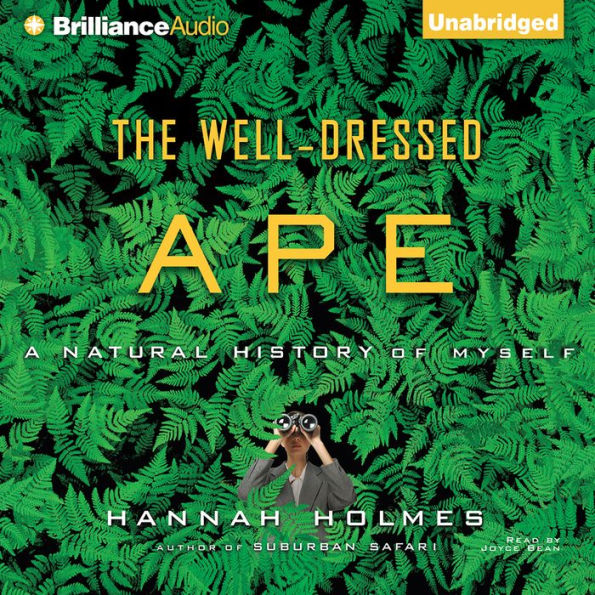While researching her previous book, Suburban Safari, in which she explored the wildlife of her backyard, Holmes realized that no field description existed for Homo sapiens. She set out to create one, and the result is sometimes illuminating and often funny…The Well-Dressed Ape is aimed at educating a general audience about human biology, and for the most part it succeeds.
—The Washington Post
The well-dressed ape, aka Homo sapiens, is a strange mammal. It mates remarkably often, and with unprecedented affection. With similar enthusiasm, it will eat to the point of undermining its own health-behavior unthinkable in wild animals. The human marks its territory with doors, fences, and plastic flamingos, yet if it's too isolated it becomes depressed. It thinks of itself as complex, intelligent, and in every way superior to other animals-but is it, really?
With wit, humility, and penetrating insight, science journalist Hannah Holmes casts the inquisitive eye of a trained researcher and reporter on . . . herself. And not just herself, but on our whole species-what Shakespeare called "the paragon of animals." In this surprising, humorous, and edifying book, Holmes explores how the human animal-the eponymous well-dressed ape-fits into the natural world, even as we humans change that world in both constructive and destructive ways.
Comparing and contrasting the biology and behavior of humans with that of other creatures, Holmes demonstrates our position as an animal among other animals, a product of-and subject to-the same evolutionary processes. And not only are we animals-we are, in some important ways (such as our senses of smell and of vision), pitiably inferior ones. That such an animal came to exist at all is unlikely. That we have survived and prospered is extraordinary.
At the same time, Holmes reveals the ways in which Homo sapiens stands apart from other mammals and, indeed, all other animals. Despite the vast common ground we share with our fellow creatures, there are significant areas in which we are unique. No other animal, as far as we know, shares the human capacity for self-reflective thought or our talent for changing ourselves or our environment in response to natural challenges and opportunities. One result of these extraordinary characteristics is the spread of our species across the entire planet; another, unfortunately, is global warming.
Deftly mixing personal stories and observations with the latest scientific theories and research results, Hannah Holmes has fashioned an engaging and informative field guide to that oddest and yet most fascinating of primates: ourselves.
The well-dressed ape, aka Homo sapiens, is a strange mammal. It mates remarkably often, and with unprecedented affection. With similar enthusiasm, it will eat to the point of undermining its own health-behavior unthinkable in wild animals. The human marks its territory with doors, fences, and plastic flamingos, yet if it's too isolated it becomes depressed. It thinks of itself as complex, intelligent, and in every way superior to other animals-but is it, really?
With wit, humility, and penetrating insight, science journalist Hannah Holmes casts the inquisitive eye of a trained researcher and reporter on . . . herself. And not just herself, but on our whole species-what Shakespeare called "the paragon of animals." In this surprising, humorous, and edifying book, Holmes explores how the human animal-the eponymous well-dressed ape-fits into the natural world, even as we humans change that world in both constructive and destructive ways.
Comparing and contrasting the biology and behavior of humans with that of other creatures, Holmes demonstrates our position as an animal among other animals, a product of-and subject to-the same evolutionary processes. And not only are we animals-we are, in some important ways (such as our senses of smell and of vision), pitiably inferior ones. That such an animal came to exist at all is unlikely. That we have survived and prospered is extraordinary.
At the same time, Holmes reveals the ways in which Homo sapiens stands apart from other mammals and, indeed, all other animals. Despite the vast common ground we share with our fellow creatures, there are significant areas in which we are unique. No other animal, as far as we know, shares the human capacity for self-reflective thought or our talent for changing ourselves or our environment in response to natural challenges and opportunities. One result of these extraordinary characteristics is the spread of our species across the entire planet; another, unfortunately, is global warming.
Deftly mixing personal stories and observations with the latest scientific theories and research results, Hannah Holmes has fashioned an engaging and informative field guide to that oddest and yet most fascinating of primates: ourselves.

The Well-Dressed Ape: A Natural History of Myself

The Well-Dressed Ape: A Natural History of Myself
FREE
with a B&N Audiobooks Subscription

Editorial Reviews
Product Details
| BN ID: | 2940169929188 |
|---|---|
| Publisher: | Brilliance Audio |
| Publication date: | 01/06/2009 |
| Edition description: | Unabridged |
Videos

